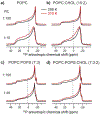Interactions of HIV gp41's membrane-proximal external region and transmembrane domain with phospholipid membranes from 31P NMR
- PMID: 34352242
- PMCID: PMC8826538
- DOI: 10.1016/j.bbamem.2021.183723
Interactions of HIV gp41's membrane-proximal external region and transmembrane domain with phospholipid membranes from 31P NMR
Abstract
HIV-1 entry into cells requires coordinated changes of the conformation and dynamics of both the fusion protein, gp41, and the lipids in the cell membrane and virus envelope. Commonly proposed features of membrane deformation during fusion include high membrane curvature, lipid disorder, and membrane surface dehydration. The virus envelope and target cell membrane contain a diverse set of phospholipids and cholesterol. To dissect how different lipids interact with gp41 to contribute to membrane fusion, here we use 31P solid-state NMR spectroscopy to investigate the curvature, dynamics, and hydration of POPE, POPC and POPS membranes, with and without cholesterol, in the presence of a peptide comprising the membrane proximal external region (MPER) and transmembrane domain (TMD) of gp41. Static 31P NMR spectra indicate that the MPER-TMD induces strong negative Gaussian curvature (NGC) to the POPE membrane but little curvature to POPC and POPC:POPS membranes. The NGC manifests as an isotropic peak in the static NMR spectra, whose intensity increases with the peptide concentration. Cholesterol inhibits the NGC formation and stabilizes the lamellar phase. Relative intensities of magic-angle spinning 31P cross-polarization and direct-polarization spectra indicate that all three phospholipids become more mobile upon peptide binding. Finally, 2D 1H-31P correlation spectra show that the MPER-TMD enhances water 1H polarization transfer to the lipids, indicating that the membrane surfaces become more hydrated. These results suggest that POPE is an essential component of the high-curvature fusion site, and lipid dynamic disorder is a general feature of membrane restructuring during fusion.
Keywords: Cholesterol; Membrane curvature; Protein dynamics; Virus-cell fusion.
Copyright © 2021 Elsevier B.V. All rights reserved.
Figures








Similar articles
-
Cholesterol Interaction with the Trimeric HIV Fusion Protein gp41 in Lipid Bilayers Investigated by Solid-State NMR Spectroscopy and Molecular Dynamics Simulations.J Mol Biol. 2020 Jul 24;432(16):4705-4721. doi: 10.1016/j.jmb.2020.06.017. Epub 2020 Jun 24. J Mol Biol. 2020. PMID: 32592698 Free PMC article.
-
Oligomeric Structure and Three-Dimensional Fold of the HIV gp41 Membrane-Proximal External Region and Transmembrane Domain in Phospholipid Bilayers.J Am Chem Soc. 2018 Jul 5;140(26):8246-8259. doi: 10.1021/jacs.8b04010. Epub 2018 Jun 22. J Am Chem Soc. 2018. PMID: 29888593 Free PMC article.
-
Cholesterol-Mediated Clustering of the HIV Fusion Protein gp41 in Lipid Bilayers.J Mol Biol. 2022 Jan 30;434(2):167345. doi: 10.1016/j.jmb.2021.167345. Epub 2021 Nov 8. J Mol Biol. 2022. PMID: 34762895 Free PMC article.
-
Elucidating ligand-bound structures of membrane proteins using solid-state NMR spectroscopy.Curr Opin Struct Biol. 2019 Aug;57:103-109. doi: 10.1016/j.sbi.2019.02.002. Epub 2019 Mar 20. Curr Opin Struct Biol. 2019. PMID: 30903830 Free PMC article. Review.
-
Bio-membranes: Picosecond to second dynamics and plasticity as deciphered by solid state NMR.Biochim Biophys Acta Biomembr. 2023 Feb;1865(2):184097. doi: 10.1016/j.bbamem.2022.184097. Epub 2022 Nov 26. Biochim Biophys Acta Biomembr. 2023. PMID: 36442647 Review.
Cited by
-
Molecular recognition of a membrane-anchored HIV-1 pan-neutralizing epitope.Commun Biol. 2022 Nov 18;5(1):1265. doi: 10.1038/s42003-022-04219-6. Commun Biol. 2022. PMID: 36400835 Free PMC article.
-
The Role of Cholesterol in M2 Clustering and Viral Budding Explained.J Chem Theory Comput. 2025 Jan 28;21(2):912-932. doi: 10.1021/acs.jctc.4c01026. Epub 2024 Nov 4. J Chem Theory Comput. 2025. PMID: 39494590 Free PMC article.
-
Lipid Selectivity of Membrane Action of the Fragments of Fusion Peptides of Marburg and Ebola Viruses.Int J Mol Sci. 2024 Sep 13;25(18):9901. doi: 10.3390/ijms25189901. Int J Mol Sci. 2024. PMID: 39337389 Free PMC article.
References
-
- Weissman D, Rabin RL, Arthos J, Rubbert A, Dybul M, Swofford R, Venkatesan S, Farber JM, Fauci AS, Macrophage-tropic HIV and SIV envelope proteins induce a signal through the CCR5 chemokine receptor, Nature, 389 981–985 (1997). - PubMed
-
- Chernomordik LV, Kozlov MM, Protein-lipid interplay in fusion and fission of biological membranes, Annual review of biochemistry, 72 175–207 (2003). - PubMed
Publication types
MeSH terms
Substances
Grants and funding
LinkOut - more resources
Full Text Sources

